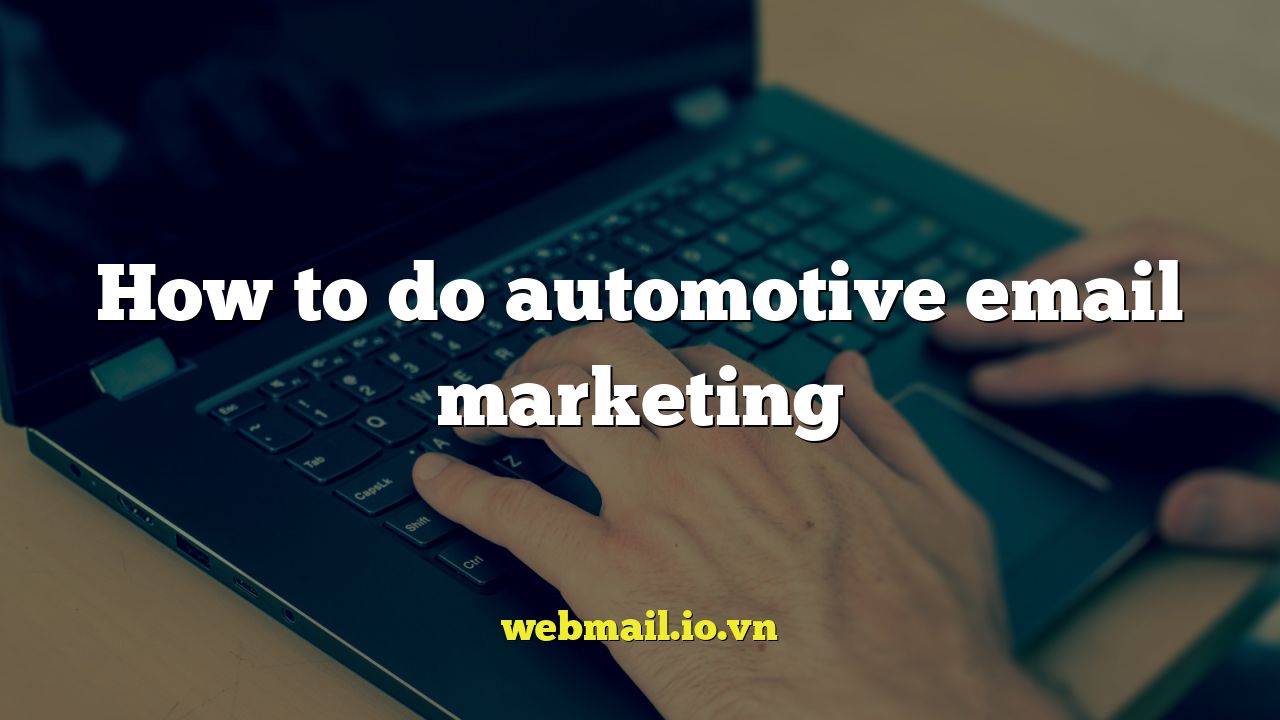
Introduction to Automotive Email Marketing
In the competitive automotive industry, effective marketing is crucial for success. Email marketing remains a powerful tool for reaching potential and existing customers, nurturing leads, and driving sales. This guide provides a comprehensive overview of how to implement successful automotive email marketing campaigns, covering everything from list building to measuring results.
Building Your Automotive Email List
The foundation of any successful email marketing strategy is a robust and engaged email list. Building your list ethically and effectively is paramount. Never purchase lists; these are often filled with inactive or uninterested contacts and can damage your sender reputation.
- Offer valuable incentives: Provide exclusive deals, discounts, or content in exchange for email sign-ups.
- Utilize website forms: Embed prominent sign-up forms on your website, including landing pages, blog pages, and even the footer.
- Run contests and giveaways: Collect email addresses as part of the entry process.
Consider offering a free service like a vehicle valuation, a download of a maintenance checklist, or early access to new model information. Ensure your sign-up forms are GDPR and CCPA compliant, clearly stating how you will use the collected email addresses.
Segmenting Your Automotive Email Audience
Sending generic emails to your entire list is unlikely to yield optimal results. Segmentation allows you to tailor your messaging to specific groups of subscribers, increasing engagement and conversions.
Consider segmenting your audience based on:
- Vehicle ownership: Target owners of specific makes, models, or years with relevant service offers or upgrade opportunities.
- Customer lifecycle stage: Differentiate between prospects, new customers, and loyal customers to send appropriate messages.
- Demographics: Segment by age, location, income, or other relevant demographic factors.
By understanding your audience and tailoring your messaging, you can create more personalized and impactful email campaigns.
Crafting Compelling Automotive Email Content
Your email content is the heart of your campaign. It needs to be engaging, informative, and relevant to your audience.
Here are some ideas for effective automotive email content:
- New vehicle announcements: Showcase new models with high-quality images, videos, and detailed specifications.
- Service reminders: Send automated reminders for scheduled maintenance, oil changes, and tire rotations.
- Special offers and promotions: Promote discounts on parts, service, and accessories.
Always include a clear call to action (CTA) in your emails, such as “Schedule a Test Drive,” “Get a Quote,” or “Learn More.” Use strong verbs and create a sense of urgency.
Automating Your Automotive Email Marketing
Email automation can save you time and effort while ensuring consistent communication with your audience. Set up automated workflows to nurture leads, onboard new customers, and re-engage inactive subscribers.
Examples of automated email workflows include:
- Welcome series: Greet new subscribers and introduce them to your dealership or brand.
- Lead nurturing: Send a series of emails to educate prospects about your products and services.
- Abandoned cart emails: Remind customers about items left in their online shopping cart.
Use marketing automation platforms to create and manage your workflows. These platforms typically offer features such as email scheduling, segmentation, and analytics.
Designing Effective Automotive Email Templates
Your email design plays a crucial role in capturing attention and conveying your message effectively. Use a clean, professional design that is consistent with your brand identity.
Consider these design best practices:
- Use responsive design: Ensure your emails render correctly on all devices, including smartphones and tablets.
- Optimize images: Use high-quality images that are optimized for email delivery. Avoid large images that can slow down loading times.
- Maintain brand consistency: Use your brand colors, fonts, and logo in your email templates.
Test your email design across different email clients and devices to ensure it looks its best for all recipients.
Measuring and Analyzing Your Automotive Email Marketing Performance
Tracking your email marketing metrics is essential for understanding what’s working and what’s not. Use analytics tools to monitor key performance indicators (KPIs) such as:
- Open rate: The percentage of recipients who opened your email.
- Click-through rate (CTR): The percentage of recipients who clicked on a link in your email.
- Conversion rate: The percentage of recipients who completed a desired action, such as scheduling a test drive or making a purchase.
Analyze your data to identify trends and optimize your campaigns for better results. Experiment with different subject lines, content, and calls to action to see what resonates with your audience. A/B testing can be very helpful here.
Compliance and Best Practices in Automotive Email Marketing
Compliance with email marketing regulations is crucial for avoiding penalties and maintaining a positive sender reputation. Familiarize yourself with regulations such as GDPR and CCPA.
Follow these best practices to ensure compliance:
- Obtain explicit consent: Always get permission from subscribers before sending them emails.
- Provide an unsubscribe link: Include a clear and easy-to-find unsubscribe link in every email.
- Honor unsubscribe requests promptly: Remove unsubscribed contacts from your list immediately.
By following these best practices, you can build trust with your audience and maintain a positive reputation as a sender.
Advanced Automotive Email Marketing Strategies
Once you have mastered the basics of automotive email marketing, you can explore more advanced strategies to further enhance your results. Consider incorporating:
Personalization: Use data to personalize your emails with recipient’s names, vehicle information, or past purchase history.
Dynamic content: Display different content based on recipient’s demographics, interests, or behavior.
Behavioral targeting: Send emails based on recipient’s actions, such as visiting a specific page on your website or abandoning a shopping cart.
Conclusion
Automotive email marketing offers a powerful way to connect with potential and existing customers, drive sales, and build brand loyalty. By following the strategies outlined in this guide, you can create effective email campaigns that deliver measurable results. Remember to stay focused on providing value to your audience, building trust, and continuously optimizing your campaigns for maximum impact.